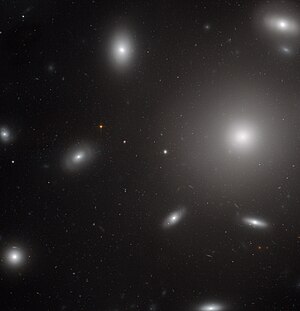NGC 4874
| NGC 4874 | |
|---|---|
 NGC 4874 dominates this picture created from optical and near-infrared exposures taken with the Wide Field Channel of Hubble's Advanced Camera for Surveys. | |
| Observation data (J2000 epoch) | |
| Constellation | Coma Berenices |
| Right ascension | 12h 59m 35.709s[1] |
| Declination | +27° 57′ 33.80″[1] |
| Redshift | 0.023937 |
| Distance | 109 Mpc (360 Mly)[2] |
| Apparent magnitude (V) | 12.7 |
| Characteristics | |
| Type | cD, Ei, E0 |
| Other designations | |
| NGC 4874, NFP J125935.7+275734, [BGH2001] 237, [KK90] 169, B2 1257+28, 10P 236, [BO85] Coma 1, [L84] A1656-G2, 5C 4.85, SDSS J125935.70+275733.3, [BTM97] ACO 1656 2, [LGF2005] B125711+281340, CAIRNS J125935.60+275734.0, TT 12, [CHM2007] LDC 926 J125935.70+2757338, [LO95] 1257+282, FOCA 0728-499, UGC 8103, [CHM2007] HDC 745 J125935.70+2757338, [MHR2010] 194.8988+27.9593, GIN 765, UZC J125935.6+275734, [D80] ACO 1656 129, [MO2001b] J125935.7+275732.3, GMP 3329, 4W 1257+28W01, [DFO95] 246, [MOL2003] A1656 J125935+275730, GP 489, 7W 1257+28W01, [DLB87] C11, [OLK95] 1257+282, LEDA 44628, WSTB 74W16, [EDG2007] 3, [OR76] 1257+282, 2MASX J12593562+2757360, Z 1257.2+2814, [FBH2004] X281, [OSR2002] b089, 2MASX J12593570+2757338, Z 160-A22, [FBH2004] S89, [PL95] ACO 1656 G2, MCG+05-31-070, Z 160A-22, [FWB89] Galaxy 321, [ZBO89] ACO 1656-5, MPMM 123, Z 160-231, [K94] 125710.70+281346.0 | |
NGC 4874 is a giant elliptical galaxy. It was discovered by the British astronomer Frederick William Herschel I in 1785, who catalogued it as a bright patch of nebulous feature. The second-brightest galaxy within the northern Coma Cluster, it is located at a distance of 109 megaparsecs (350,000,000 light-years) from Earth.
Characteristics[]
The galaxy is surrounded by an immense stellar halo that extends up to one million light-years in diameter. It is also enveloped by a huge cloud of interstellar medium that is currently being heated by action of infalling material from its central supermassive black hole. A jet of highly energetic plasma extends out to 1,700 light-years from its center. The galaxy has 18,700 ± 2,260 globular clusters.
See also[]
- List of largest galaxies
References[]
- ^ a b "SIMBAD basic query result". SIMBAD Astronomical Database. Retrieved 20 September 2011.
- ^ "Galaxies in a Swarm of Star Clusters". Picture of the Week. ESA/Hubble. Retrieved 20 September 2011.
External links[]
 Media related to NGC 4874 at Wikimedia Commons
Media related to NGC 4874 at Wikimedia Commons
Categories:
- Elliptical galaxies
- NGC objects
- Coma Cluster
- Coma Berenices
- Elliptical galaxy stubs